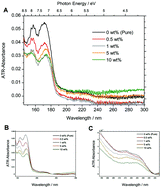当前位置:
X-MOL 学术
›
Phys. Chem. Chem. Phys.
›
论文详情
Our official English website, www.x-mol.net, welcomes your feedback! (Note: you will need to create a separate account there.)
Rydberg transitions as a probe for structural changes and phase transition at polymer surfaces: an ATR-FUV-DUV and quantum chemical study of poly(3-hydroxybutyrate) and its nanocomposite with graphene†
Physical Chemistry Chemical Physics ( IF 3.3 ) Pub Date : 2018-02-21 00:00:00 , DOI: 10.1039/c7cp07271f Krzysztof B. Beć 1, 2, 3, 4, 5 , Yusuke Morisawa 1, 5, 6, 7, 8 , Kenta Kobashi 1, 2, 3, 4, 5 , Justyna Grabska 1, 2, 3, 4, 5 , Ichiro Tanabe 5, 9, 10, 11 , Erika Tanimura 1, 2, 3, 4, 5 , Harumi Sato 5, 12, 13, 14 , Marek J. Wójcik 1, 2, 3, 4, 5 , Yukihiro Ozaki 1, 2, 3, 4, 5
Physical Chemistry Chemical Physics ( IF 3.3 ) Pub Date : 2018-02-21 00:00:00 , DOI: 10.1039/c7cp07271f Krzysztof B. Beć 1, 2, 3, 4, 5 , Yusuke Morisawa 1, 5, 6, 7, 8 , Kenta Kobashi 1, 2, 3, 4, 5 , Justyna Grabska 1, 2, 3, 4, 5 , Ichiro Tanabe 5, 9, 10, 11 , Erika Tanimura 1, 2, 3, 4, 5 , Harumi Sato 5, 12, 13, 14 , Marek J. Wójcik 1, 2, 3, 4, 5 , Yukihiro Ozaki 1, 2, 3, 4, 5
Affiliation

|
We investigated the surface (<50 nm) of poly(3-hydroxybutyrate) (PHB) and its nanocomposite with graphene by attenuated total reflection far- and deep-ultraviolet (ATR-FUV-DUV; 145–300 nm; 8.55–4.13 eV) spectroscopy and quantum mechanical calculations. The major absorption of polymers occurs in FUV and is related to Rydberg transitions. ATR-FUV-DUV spectroscopy allows for direct measurements of these transitions in the solid phase. Using ATR-FUV-DUV spectroscopy, periodic density functional theory (DFT) and time-dependent DFT (TD-DFT), we explained the origins of the FUV-DUV absorption of PHB and provided insights into structural changes of PHB which occur upon formation of a graphene nanocomposite and upon heating of the pure polymer. The structural changes cause specific and gradual spectral variations in FUV-DUV. We systematically studied the relaxation of the polymer helix and concluded that the common feature of all models of the unfolded helix lies in a specific and consistent FUV-DUV spectral signature. Relaxed structures feature a blue-shift of the major FUV transition (non-bonding molecular orbital to Rydberg 3p and π to π*) as compared with crystalline PHB. The FUV absorption of the relaxed structures was determined to be significantly stronger than that of the crystalline state. These results are consistent with the observed temperature-dependent spectra of the pure PHB. The simulation of the thermal expansion of the crystalline polymer by a periodic-DFT study allows us to exclude the possibility that spectral variations observed experimentally are influenced by changes in the crystalline phase. We concluded that the crystallinity of PHB at the sample surface increases with an increase in graphene content in the nanocomposite. However, it is unlikely that the polymer structure inside the crystal is affected; instead the FUV-DUV spectral variations result from changes in the polymer morphology that occur at the sample surface. The phase transition of PHB is affected by temperature and addition of graphene content. These changes are likely to be the opposite of those occurring in the bulk sample.
中文翻译:

Rydberg转变作为聚合物表面结构变化和相变的探针:ATR-FUV-DUV和聚(3-羟基丁酸酯)及其与石墨烯的纳米复合材料的量子化学研究†
我们通过衰减远和深紫外线的全反射(ATR-FUV-DUV; 145-300 nm; 8.55-4.13 eV)研究了聚(3-羟基丁酸酯)(PHB)及其与石墨烯的纳米复合材料的表面(<50 nm) )光谱学和量子力学计算。聚合物的主要吸收发生在FUV中,并且与Rydberg跃迁有关。ATR-FUV-DUV光谱法可直接测量固相中的这些跃迁。使用ATR-FUV-DUV光谱,周期性密度泛函理论(DFT)和时变DFT(TD-DFT),我们解释了PHB的FUV-DUV吸收的起源,并提供了对形成后PHB的结构变化的见解。石墨烯纳米复合材料的制备和加热纯聚合物时的制备。结构变化导致FUV-DUV发生特定且逐渐的光谱变化。我们系统地研究了聚合物螺旋线的弛豫,并得出结论,所有展开螺旋线模型的共同特征在于特定且一致的FUV-DUV光谱特征。与晶体PHB相比,弛豫结构的特征是主要的FUV跃迁发生蓝移(分子轨道至Rydberg 3p的非键合分子,π至π*的非键合分子)。经测定,松弛结构的FUV吸收明显强于结晶态。这些结果与观察到的纯PHB的温度相关光谱一致。通过定期DFT研究对结晶聚合物的热膨胀进行模拟,使我们可以排除实验观察到的光谱变化受结晶相变化影响的可能性。我们得出结论,样品表面PHB的结晶度随纳米复合材料中石墨烯含量的增加而增加。但是,晶体内部的聚合物结构不太可能受到影响。FUV-DUV光谱变化取而代之的是样品表面发生的聚合物形态变化。PHB的相变受温度和石墨烯含量的增加的影响。这些变化可能与散装样品中发生的变化相反。PHB的相变受温度和石墨烯含量的增加的影响。这些变化可能与散装样品中发生的变化相反。PHB的相变受温度和石墨烯含量的增加的影响。这些变化可能与散装样品中发生的变化相反。
更新日期:2018-02-21
中文翻译:

Rydberg转变作为聚合物表面结构变化和相变的探针:ATR-FUV-DUV和聚(3-羟基丁酸酯)及其与石墨烯的纳米复合材料的量子化学研究†
我们通过衰减远和深紫外线的全反射(ATR-FUV-DUV; 145-300 nm; 8.55-4.13 eV)研究了聚(3-羟基丁酸酯)(PHB)及其与石墨烯的纳米复合材料的表面(<50 nm) )光谱学和量子力学计算。聚合物的主要吸收发生在FUV中,并且与Rydberg跃迁有关。ATR-FUV-DUV光谱法可直接测量固相中的这些跃迁。使用ATR-FUV-DUV光谱,周期性密度泛函理论(DFT)和时变DFT(TD-DFT),我们解释了PHB的FUV-DUV吸收的起源,并提供了对形成后PHB的结构变化的见解。石墨烯纳米复合材料的制备和加热纯聚合物时的制备。结构变化导致FUV-DUV发生特定且逐渐的光谱变化。我们系统地研究了聚合物螺旋线的弛豫,并得出结论,所有展开螺旋线模型的共同特征在于特定且一致的FUV-DUV光谱特征。与晶体PHB相比,弛豫结构的特征是主要的FUV跃迁发生蓝移(分子轨道至Rydberg 3p的非键合分子,π至π*的非键合分子)。经测定,松弛结构的FUV吸收明显强于结晶态。这些结果与观察到的纯PHB的温度相关光谱一致。通过定期DFT研究对结晶聚合物的热膨胀进行模拟,使我们可以排除实验观察到的光谱变化受结晶相变化影响的可能性。我们得出结论,样品表面PHB的结晶度随纳米复合材料中石墨烯含量的增加而增加。但是,晶体内部的聚合物结构不太可能受到影响。FUV-DUV光谱变化取而代之的是样品表面发生的聚合物形态变化。PHB的相变受温度和石墨烯含量的增加的影响。这些变化可能与散装样品中发生的变化相反。PHB的相变受温度和石墨烯含量的增加的影响。这些变化可能与散装样品中发生的变化相反。PHB的相变受温度和石墨烯含量的增加的影响。这些变化可能与散装样品中发生的变化相反。



























 京公网安备 11010802027423号
京公网安备 11010802027423号